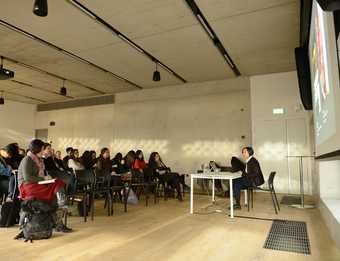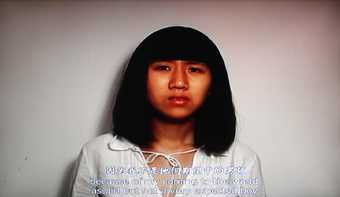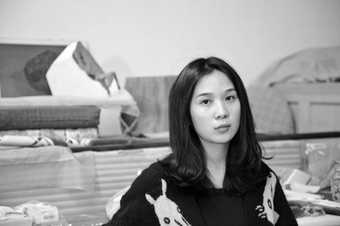
Hu Xiaoyuan
Image courtesy of the artist
Monica Merlin: What do you think about the status of women artists in contemporary Chinese art?
Hu Xiaoyuan: Many books on contemporary art have been published in recent years, particularly on Chinese contemporary art, several books a year, some published overseas, some in China. The problem is not that there are few women artists, but that many books treat women artists in a certain way. I do not think male and female artists have fundamental differences, apart from their inherent gender differences. In fact, women artists vary a lot from one another. For instance, some are more thinkers than others. We should open our minds and present a variety of ways of seeing women artists rather than repeating the same tropes that comply with ideas about women that are rooted in the past.
Monica Merlin: I agree. What you said is important. When I research women artists, I seek to truly understand the differences between their lives, thoughts and artistic approaches. Gender differences are also important to me. When we grow up, we experience how gender is differentiated in society through the division of roles – for example, a family has different expectations for a boy or girl in terms of their clothing, attitude and career. But not everything can be explained in terms of gender. I am researching women artists but I hope you do not feel that in doing so I am marginalising you. Of course that is not my intention. In history, art history and art criticism, there is very little focus on women artists. It is important to comprehend women artists who practice today, see what they do and how they think. This has yet to be done properly.
Hu Xiaoyuan: So you are working on research that is meaningful to the world and to art. You chose women artists, but your research is not necessary meaningful only in terms of men or women.
Monica Merlin: Gender difference does exist, male chauvinism exists in the world of galleries and art fairs, and the art world in general.
Hu Xiaoyuan: Yes, this is a problem. It is the current situation not only in China or Japan, but all over the world. First, we should accept the fact that the problem exists and then find our own position. No matter how much you try to criticise or resist it, the problem will not go away. Then we can decide what to do, either solve the problem or establish our own perspective within the current circumstances.
Monica Merlin: Can you talk about the development of your practice starting from when you graduated?
Hu Xiaoyuan: I graduated in 2002. I did not get a stable job because I did not want to. I received some scholarships at university and had some savings. I thought I would carefully spend my savings so that I did not need to get a job. I could make art as I liked for a while as long as my finances allowed. I was very lucky. Just over one year after graduation, around October 2003, I started exhibiting as part of a group that included both male and female artists, all of whom were my friends. The group, which was made up of twelve artists, was called N12. We formed a seemingly organised group which was in reality quite disorganised. Since then, I have never stopped exhibiting. Gallery exhibitions or collaborations have taken place one after another. In 2010, I started a stable collaboration with Beijing Commune, which represents me.
Monica Merlin: Between 2005 and 2007, you made two very interesting pieces: A Keepsake I Cannot Give Away and Those Times. They are connected to traditional culture and history as well as to your personal experience, your family and the women in your family. Can you talk about these two works?
Hu Xiaoyuan: It is more or less as you said. But the first one of your two points – tradition and history – was not my deliberate subject. The reason is simple. Take you, for instance, a young person from another culture. Perhaps you do not stress or accept your own traditional culture, but you are surrounded by information and experiences related to tradition. You may see a traditional art exhibition or listen to traditional music. You won’t proactively seek it out, but it has an imperceptible influence on you mentally and physically. When you make art, you do not try to hold on to it, but it follows you around and affects your approach and your final work. You cannot reject it. Because from the day you are born – take someone in their thirties, for instance – for over thirty years, it has been affecting you like the air around you. So it will naturally be evident in your work.
As to your other point regarding myself and my family, that is inevitable. That is also the reason why one artist is different from another. In A Keepsake I Cannot Give Away, I used embroidery. Actually I never learned to do it, but at home when I was a child, my mum used a sewing machine to make lots of pretty clothes for me. I was born in 1977; back then, it was not possible to buy a lot of things because the country was poor. She made lots of clothes and accessories for me, such as dresses or bags. She also did embroidery, which intrigued me. I wanted to learn it but she did not allow me to. At the age of twelve, she got me a professional art tutor to teach me drawing and painting. She was an accountant in a state-owned company. From when I was little, she had always thought that I should become a different person from her, and that I should receive good education and have a good future. So she did not like the idea that I would do things like sewing or embroidery.
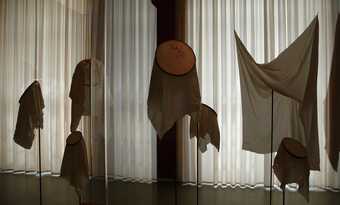
Hu Xiaoyuan
A Keepsake I Cannot Give Away 2007
Image courtesy of the artist
So I did not learn sewing or embroidery but I saw how my mother did it. Or perhaps I had the dexterity in my DNA and inherited her skills without practicing them. When I was making A Keepsake I Cannot Give Away, I realised that I did not need to learn. I knew that I could control the hair I used in the piece and turn it into something that I wanted. I imagined all the patterns. The works are in groups of two in different sizes. One of the two patterns is based on a part of my body. I learned sketching from a young age. It is basically a simple line drawing using hair. For instance, my finger, my mouth, my hair, or my breast. The other pattern looks like just a flower or bird to you, but it means something different to a Chinese person, particularly one who is interested in traditional culture. They can tell that the pair of birds are mandarin ducks, and these have a special meaning. But a foreigner would not realise that. The second pattern is related to tradition, love, marriage, promise or emotions. Chinese people can interpret these patterns.
My personal feelings are also expressed in the work. My husband and I have been together for seventeen years now, since high school. It might be hard to imagine. During these seventeen years, I gradually came to a realisation. You would think that we are very close to each other because we are together every day, almost as though we were conjoined twins, and because we got together when we were very young and we grew up together. But I realised that this is not true at all. Now I believe that each person is born alone and will die alone. You may drink tea and sleep together, but two hearts will never become one. When I made the series, I felt sentimental. No matter how much I see the distance between people and wish it to be different, this is beyond my control. I can spend a lot of time thinking about making an object, but giving it to you does not mean that you will understand it. In fact maybe you will never understand it. It is as though you may hear my words but never understand them. Many things cannot be expressed fully through text, music or art. That is why the series is called A Keepsake I Cannot Give Away.
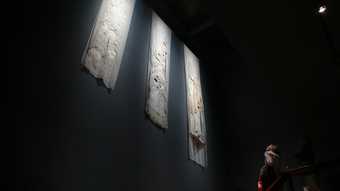
Hu Xiaoyuan
Those Times 2006
Image courtesy of the artist
The three banners in Those Times are made of objects used by the women in my family. When I was ten, my grandma – my mother’s mother – started living with us. She had several sons and one daughter, my mother. She lived with us for some years towards the end of her life because my mum is her youngest. The three of us shared many things around the house; for example, my mum’s shirt was made by my grandma – she wore it when she was young but later she put on weight and stopped wearing it. The shirt was made of nice silk and my mum took good care of it. I thought it was a great piece of vintage and wore it in high school. Many things were shared between us.
When I graduated from university, my mother had already retired. I hoped she would come with me to live in Beijing – I am from Harbin, in the north. I thought a lot about how I could make that happen. Back then, properties were not as expensive as they are now. I used the money from selling my first piece of art to buy a flat for my parents. I said to them, ‘You see, I have bought a flat for you, so you should move here.’ You might not know this: Chinese parents can barely live without their children and must stay close to their children. They decided to move here and sold the flat in our hometown. When the flat was sold, a lot of things needed to be thrown out or packed away. It crossed my mind that there might be things that I could use. So I took a flight back and organised things with them. Some long-forgotten items suddenly jumped into my sight and made me excited, sad and emotional. I kept those items. When moving into the new flat, I was thinking about how to use them. I felt closely related to them and it was not enough to keep them in small boxes. So, I made the series. The ownership of the objects in the three banners is determined by whoever last used them. One banner is mine, one is my mother’s and the other my grandma’s. My grandma had passed away when I made the series. She died in her eighties.
The two series are especially connected to the state of mind that I was in at that time. I was just under thirty years old. My feelings, my mental situation and my life were all rather unstable. I had just graduated when I decided to live in this city. Then my family moved. Many things happened quickly and unsettled me. So, in these works, sentiments are important. There is also a sense of insecurity in A Keepsake I Cannot Give Away. In brief, they are closely related to my life at a certain stage. As you said earlier, it is important to understand an artist’s life so that you can learn why they make art and what the relation is between their work and their experience as well as the perspective from which they look at the world.
Monica Merlin: So 2005 to 2007 was an important phase in both your life and your art.
Hu Xiaoyuan: Yes. My life situation led my art to a new phase. Look at my catalogue and my later work. This period was a dividing line. After that, there are clear changes in my thinking and my approach to the world.
Monica Merlin: What changes in your thinking were important to you?
Hu Xiaoyuan: Many things during that phase felt beyond my grasp. I constantly felt as though I had nothing. I did not feel secure because I felt many things could attack me. I felt a sense of danger. Later, I stopped working for a while and had some rest, because I knew that if I continued in that state I would no longer be able to work. A state like that will narrow and limit a person’s view of the world.
After some rest, I realised that if I looked at or thought about the same thing from a different angle, the situation would appear differently. For instance, a statue. When you look at a statue from its front, the figure might look evil or ugly. If you stay in this position without moving, you will find the statue appalling and remember it as appalling forever. But, in fact, the statue cannot move whereas you can. You can move to the back and look at it from there. Maybe from the back the statue shows the warm and harmonious colour of the sunset. And because you cannot see the face, it seems different. An alternative perspective can allow for different possibilities.
When you know that something won’t change, you should change the way you see it. Once you have changed the way you see it, new possibilities will appear and these can be completely different from what you had previously seen – the appalling view for instance. You can use this approach to look at the world again.
Monica Merlin: I can see a variety of practices and materials in your work, including painting, installation and video. Is there one medium that best expresses your ideas and concepts?
Hu Xiaoyuan: This question is too extreme because a person changes every day, and so does the world. For example, before you arrived here, I did not know you and we had never communicated with each other. But now we are sitting next to each other and chatting. I might get useful information from what you say. This information might influence me. When you leave here a bit later, your influence will have stayed with me and I will have changed. The change might not be obvious or dramatic, but I will absolutely be different in a subtle way. In China, we like to speak about the last second, this second and the next second. Everything, including yourself, is constantly changing. A person is not the same person they were a moment ago.
Speaking of my approach and the media that I use, is there one unchanging thing that can suit a person whose thinking is constantly changing? I do not think so. But there can be the most suitable approach at a given time. That is why sometimes I use video, sometimes installation and other times painting. Now I am painting the wood series. It is the most reasonable and functional medium for me to use now. One day I may present my ideas in video. Then there must be a linear connection between those ideas and my ideas now. I will choose video because it is more direct and reasonable than other media in expressing my ideas at that time. So it is a flexible thing.
Contemporary artists are not ‘painters’ in a traditional sense. A painter can be a contemporary artist, but a contemporary artist is not necessarily a painter. I see a subtle difference between the two – those who use painting to represent the world and those who deploy various means to express themselves.
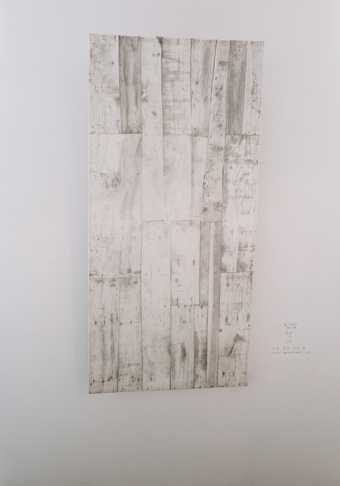
Hu Xiaoyuan
Wood 2008
Image courtesy of the artist
Monica Merlin: Can you tell me more about the wood series that you are doing?
Hu Xiaoyuan: My earliest wood works were from 2008. That was five years ago. The very first wood work is different from my recent works. Do you know that Chinese people do not like to sleep on soft bed mattresses? Instead, we like to sleep on hard wood boards with a thin cotton bed pad on top. I am the same. I have never liked soft mattresses ever since I was little. I feel uncomfortable after sleeping on a soft one, but I’ve heard many European people saying, ‘How can you get up the next morning after sleeping on a board?’ I used an old single bed board in my first wood piece. When a bed board has been used for a long time, traces of the sleeper will show, such as sweat or stains. I painted a bed board like that where you could see the grains of the wood.
Monica Merlin: Whose bed board is this?
Hu Xiaoyuan: I don’t know. I got it from a rented flat. I was not the only person who had slept on it, but I became its owner. I used xiao, a thin and semi-transparent fabric made of raw silk. It has a certain degree of rigidity and is not too limp. I put it on top of the wood board and traced all the grain that I could see. Then I put the fabric aside and covered the board’s surface with paint. Later, I framed the fabric on the board using tiny nails in the same way that you stretch an oil painting in a frame.
It was interesting because the silk is not totally transparent. It is eighty per cent see-through. I paint wherever I feel there is a grain in the wood, but sometimes I am hesitant and not sure if there is a grain, so I lift up the silk and discover that there is not actually a grain and I painted too much. Then I lay the silk down again and carry on painting. At other times, the opposite happens – where I think there is not a grain it turned out to be a grain. I felt that what I paint should be identical with the wood. If I put the silk and the wood board side-by-side, everyone should be able to tell that the board was the object of the painting. But it is not the case. When the painting is completed, the two things do not look identical. Isn’t this like what I said earlier – the relations between the last second, this second and the next second? These kind of strange relations have always fascinated me.
That is how my wood series started. Why do I paint the wood board white and frame my painting on the board? That is related to another thought. My friends and I have often had the feeling that ‘I am not good enough’. So when you are with someone, you try to be at your best. You cover yourself up and try to project an idealised version of yourself. But when you become closer and closer to this person, no matter how much you cover up, the other person can see through you. I find it weird. It is as though your efforts have been in vain. You try so hard to say that ‘I am not like that’, but people do not believe you. I feel that the painted silk on top of the board is like the second layer of skin of the board underneath. It is connected to the other, but is not the same. They are two different perspectives.
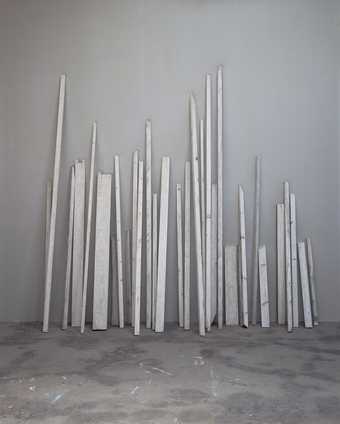
Hu Xiaoyuan
Wood 2010
Image courtesy of the artist
This year I participated in Statements at Art Basel, where I exhibited a group of nine wood paintings. The wood was all taken from waste materials, big and smaller pieces. A carpenter I knew assisted me. He loves wood as a material and picks up any random piece – as long as it is wood – and brings it back to life. He does not always know what he can do with the wood, but he knows that it is a pity to throw it away. I found a pile of this material at his place. The pieces of wood looked so strange that you could not possibly imagine where they were from. I had no idea if they would be useful or not. They were just piled up randomly. For example, there was this stool, too narrow to sit on and too tall to step onto. I said to him, ‘If they are useless to you, why don’t you give them to me?’ I took them and made the series.
The interesting thing about the series is that all the works are made from waste material. I worked very slowly because the wood grain was very detailed and spent a long time painting their surfaces after which I would frame the paintings on the wood. Before the exhibition opened, I arranged the works on the floor in the middle of the room. Many people arrived expecting to see my new work. They walked straight to the middle of the room and asked me, ‘Where are the pieces?’ The work was invisible to them! But I liked that. I wanted to make something exhausting and full of effort, which takes a lot of my enthusiasm and energy, but where the final work is barely noticeable to its audience.
Monica Merlin: Are your recent works connected to the wood series?
Hu Xiaoyuan: No. I made some video works recently. I also made some works connected to the wood series, but my latest work is an installation, which will be completed next year. I have had the idea for a while but I am only drafting it now.
Monica Merlin: When did you start thinking about it?
Hu Xiaoyuan: I started planning it last year. I will start making it at the end of this year because I want to include it in my solo exhibition next year.
Monica Merlin: Where will your solo exhibition be next year?
Hu Xiaoyuan: At Beijing Commune. Their artists rotate like shift workers and every artist has a solo exhibition every two years. The space is not that big, so for an artist, two years is just about right, I think.
I am still working with xiao, raw silk and some everyday objects, while continuing to experiment with them. For example, [gestures to an object] this is a pomegranate. They are huge before drying out. I will buy a big and fresh pomegranate, cover it with xiao and sew it up. A pomegranate has a lot of colours, patterns and spots on its skin. I will paint all the details that I can see with a brush pen on the xiao. Then I will put the whole thing aside and wait for it to dry. When it is dry, the fabric will appear hollow, because the fabric does not shrink whereas the pomegranate inside will become smaller. I am also experimenting with eggs. I cover them with xiao and wait for them to change. Other objects are wood triangles, stone, caster sugar and balloons. A balloon will be purely white and there is no need to paint anything. It will become deflated after a long time, but the fabric outside will remain.
When you paint something, you think you have seen everything about the object. When you see something, you think its appearance is all there is. I paint the look of objects, yet after a while, the objects change under the xiao that covers them. Which is real, the objects or the hollow layer outside? Neither. The real things exist in the gaps between them – what has disappeared is real.
Monica Merlin: …or perhaps all three are real.
Hu Xiaoyuan: Maybe. But none of them is everything.
Monica Merlin: You can see the changes when a pomegranate dries, but you cannot see any change with eggs.
Hu Xiaoyuan: That’s right. Let’s take stone and wood for instance. They may exist in the world longer than we do. They change slowly, but we do not last long enough to see their changes. We cannot see their gradual change. In fact, there are many things we cannot see. It depends on how you think about it. What I like to show in my work are imperceptible changes. This kind of slow change is a real change.
Monica Merlin: I can imagine this work will be different in twenty years.
Hu Xiaoyuan: Yes. Is there anything that never changes? All my works will change.
Monica Merlin: Can you talk about the different materials you use?
Hu Xiaoyuan: Some works are made with toilet tissue used by myself. I collected used toilet tissue rather than throwing it into the toilet. I wore rubber gloves, put it in a bucket, added water and glue, and made it into paper pulp. It is a bit gross, but I do not mind because I used it myself. I made a skull with it. When I first made it a long time ago, it was life-size. But with the passing of time, it has become so small that it looks like a monkey’s head, because the water has dried out from the paper pulp.
Monica Merlin: When you exhibit now, do you show recent works only, or do you show works from 2005 to 2007 as well?
Hu Xiaoyuan: It is impossible to exhibit older works because they have all been sold. I make new work for every exhibition.
I won’t have a title at the entrance to my next exhibition but I can only show you this cicada. They are everywhere in Beijing, but not in this season. I used the shells they shed after they hatch in a previous work, but this time I will use six live cicadas. I plan to do it in September next year, which is the season when cicadas are about to die. I will capture six dying cicadas. I will glue their legs to the wall at the entrance to the exhibition so they form six dots, which looks like a Chinese ellipsis. In that season, cicadas are very loud because they make a lot of noise when they are close to death.
Monica Merlin: Performance art with cicadas as the actors.
Hu Xiaoyuan: Yes, and they will have an audience. I will also show some new wood series works, but you cannot see them in my studio yet. They are the larger and more complicated pieces. There will also be a piece of video work. Have you noticed that in late autumn, in parks, you often see a dead insect withering away in the wind on a tree surrounded by other insects, such as ants, who are busy working around it or eating it? But the dead insect is. That is the inspiration of this video piece.
Monica Merlin: Thank you for such a stimulating conversation.
Monica Merlin interviewed Hu Xiaoyuan in her studio in Beijing on 8 November 2013.
Published 21 February 2018

